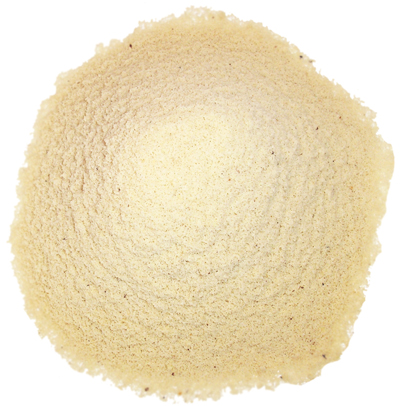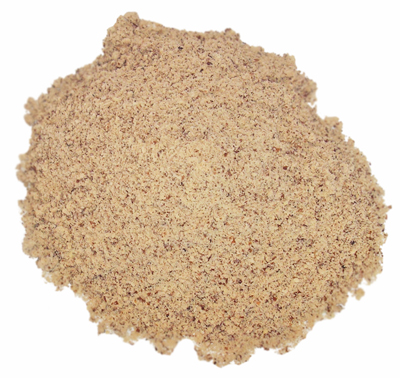 | Almond Flour
- Almond flour is ground almonds that have the outer, dark skin of the almond removed (uses blanched almonds).
- Just Almonds uses the freshest almonds to create our almond flour.
- Prices start at $7.70/lb. Quantity discounts start at 5 lbs. Click on the button on the right to view discounts.
- Made from 100% natural California almonds
 - Prized for their superior size and taste
- No preservatives; no artificial ingredients
- Kosher certified
- Certified Gluten-free
- Premium Quality
- Guaranteed Freshness
- Naturally Fresh Foods
|
 | Almond Meal
- Almond meal is ground almonds that have the outer skin left on.
- Just Almonds uses the freshest almonds to create our almond meal.
- Prices start at $5.80/lb. Quantity discounts start at 5 lbs. Click on the button on the right to view discounts.
- Made from 100% natural California almonds
 - Prized for their superior size and taste
- No preservatives; no artificial ingredients
- Kosher certified
- Certified Gluten-free
- Premium Quality
- Guaranteed Freshness
- Naturally Fresh Foods
|
Nutritional Value of Almond Flour
Almond flour is very nutritious, easy to use and readily available. It’s also a great alternative for those of us who need to watch our glycemic index. Almond flour is high in protein, low in carbohydrates and low in sugars.
Unlike other alternatives to
wheat flour, almond flour is moist and delicious. Almond flour is far
superior to other flours in terms of taste, nutrition and ease-of-use.
A new study has found that
naturally-occurring chemicals found in the skin of almonds may help
boost the immune system’s response to infection.
Researchers with the Institute of Food Research have found that the nut skins improved the ability of white blood cells
to detect viruses, including those that cause flu and the common cold,
while also increasing the body’s ability to prevent the viruses from
replicating and spreading. In the lab, the scientists found that even
after digestion, almond skin extracts were still effective in boosting the immune system although boiling the nuts seemed to decrease activity.
Although nutritional
guidelines suggest three ounces a day for other health benefits,
research still needs to be done to find out how much to eat for the
antiviral effect.
Uses of Almond Flour and Almond Meal
Almond flour is good in "quick-bread" type recipes, like muffins, nut breads, and pancakes. It's not good for foods such as bread that require a real
dough (you can't knead it). Usually, more eggs are required when baking
with almond meal to provide more structure.
Almond meal can also be used in breading fish, but care must be taken not to burn it.
Making Almond Flour
Almond Flour can make it in a blender or food processor, though care must be taken not to go too far, or you will have almond butter! Use fairly small amounts, and pulse until it's meal.
Storing Almond Flour
You can store almond flour in gallon or half-gallon glass mason jars and leave one in your fridge and leave the others in the freezer. Using almond flour straight out of the freezer is an exercise in clumpy frustration.
Shelf Life of Almond Flour
You can keep it refrigerated for up to 6 months, sometimes longer. Freezing seems to extend shelf life even more.
Use Almond Flour if You Have Wheat Allergies
According to the Mayo Clinic,
a wheat allergy is an abnormal immune system reaction to one or more
proteins found in wheat. And, an allergy to wheat is one of the more
common food allergies in children.
If you or your child has a
wheat allergy, the immune system has developed a specific antibody — a
disease-fighting agent — to a wheat protein.
Wheat allergy may result in a wide range of symptoms, including hives, difficulty breathing and nausea. Wheat allergy can also cause a life-threatening reaction called anaphylaxis.
The primary treatment for a wheat allergy is to avoid wheat in all
forms. Depending on the severity of the reaction, you also may have to
consider managing reactions with medication.
A wheat allergy may not be a
life-long disorder. Whether or not you outgrow it may depend, in part,
on when the allergy first appears. Wheat allergy in children usually
develops during infancy or early toddler years. Most children with wheat
allergy have other food allergies. Children usually outgrow wheat allergy between ages 3 and 5. Wheat allergy isn't as common in adolescents and adults.
Wheat Allergies and Celiac Disease
An allergic reaction to wheat is different from Celiac disease.
Celiac disease is an immune system reaction that causes inflammation in
the small intestines when a person eats any food containing gluten, one
type of protein found in wheat. Celiac disease, or gluten-sensitive
enteropathy, is considered food sensitivity rather than a food allergy.
Celiac disease is an immune system reaction to gluten that causes
inflammation in the small intestines. This condition can result in poor
absorption of essential nutrients from your food. A person may have both wheat allergy and celiac disease.
If or someone that you know
has a wheat allergy, you will likely experience symptoms within a few
minutes to a few hours after eating something containing wheat. Wheat allergy symptoms include:
• Swelling, itching or irritation of the mouth or throat
• Hives, itchy rash or swelling of the skin
• Nasal congestion
• Itchy, watery eyes
• Difficulty breathing
• Cramps, nausea or vomiting
• Diarrhea
• Anaphylaxis
Sources of Wheat Proteins
Foods that may include wheat proteins include:
• Breads
• Cakes and muffins
• Breakfast cereals
• Pasta
• Couscous
• Crackers
• Beer
• Hydrolyzed vegetable protein
• Soy sauce
• Condiments, such as ketchup
• Meat, crab or shrimp substitutes
• Coffee substitutes
• Meat products, such as hot dogs
• Dairy products, such as ice cream
• Natural flavorings
• Gelatinized starch
• Modified food starch
• Vegetable gum
If you have a wheat allergy, you may also be allergic to other grains with similar proteins. These related grains include:
• Barley
• Oat
• Rye
Foods Commonly Containing Wheat
Here is the list of some of the foods to watch out for:
• Snacks - crackers, chips, cereals, snack mixes, pretzels
• Breads - bread, bagels, muffins, rolls, pastries, donuts, pancakes, waffles
• Desserts - cakes, cookies, baking mixes, pies, other baked goods
• Soups - most soups including broths
• Pastas - noodles, packaged dinners containing pasta
• Condiments - soy sauce, Worchester sauce, salad dressings, barbeque sauces, marinades, glazes, some vinegars
• Beverages - Beer (including non-alcoholic), root beer, drink mixes such as instant breakfast
• Meats - frozen meats (some are packaged with broth), lunch meats, hot dogs
• Gravies and Sauces - most likely thickened with wheat flour
• Misc. - flour tortillas, stuffing
• Tabbouleh, Tabouleh or Tabouli - a salad made with bulgur
• Pilafs
If you discover that you do
have a wheat allergy, then consider cooking with almond flour. It's
nutritious and can be purchased in bulk for all your cooking needs.
Wheat-free Diets
Wheat-free diets take three forms: wheat-free, wheat and gluten-free, or wheat, gluten and casein-free.
Wheat allergies, like many
allergies, range from mild to severe. You may be able to eliminate wheat
flour from your diet by avoiding traditional breads, muffins, cakes,
cookies and gravies and resolve your discomforts. But some foods that
you wouldn't connect to wheat allergies, including cheese and pickles,
can also cause symptoms.
Persons with celiac disease,
for instance, are generally unable to tolerate gluten, a binding agent
found in wheat, barley and rye, as well as wheat. And some people allergic to wheat
are also intolerant of casein, a milk protein used to bind cheese and
other foods. A diet free from wheat, gluten and casein may also
alleviate some of the symptoms of autism, according to research
conducted in England, Norway and the University of Florida.
Hidden Wheat
Wheat is commonly found in
bread, pasta, crackers, couscous, semolina and bulgur. It can also be
hidden in starches and flavorings. Since January 2006, the Food Allergen
Labeling and Consumer Protection Act requires that food containing
wheat and seven other common food allergies be labeled.
Reading Labels
Label-reading is trickier for gluten-free dieters. If a product contains wheat gluten,
it must legally be labeled in the allergy-warning section of its label.
But if the source of gluten is barley or rye, such a label is not
required. If you need to avoid gluten, look specifically for the word
"gluten" in the list of ingredients. Other ingredients that may include
gluten but not be labeled as such include extracts, starches and
dextrin.
Followers of a gluten-free diet may eat grains such as wild rice, corn, buckwheat, millet, oats, soybeans, almonds and sunflower seeds. Casein
sources Casein is found in most products containing cow dairy,
especially cheese. It can also be found in some other cheeses, such as
those made from goat and sheep's milk, and in some non-dairy cheeses,
including almond and soy. If a product contains casein, the "casein"
should appear in the list of product ingredients.



